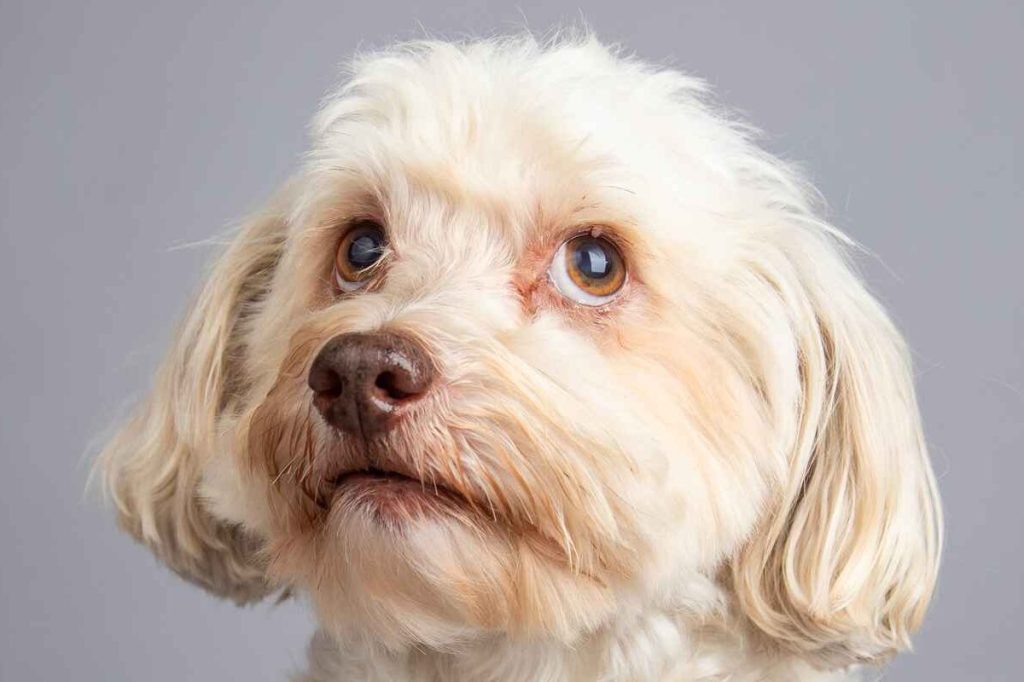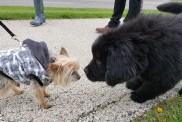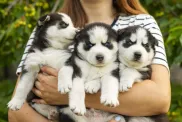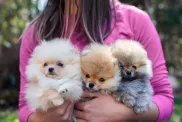The Havapoo, also called the Havoodle, is a small to medium-sized mix between the Havanese and Poodle. One of the most notable features of the Havapoo dog, also called the Havadoodle or Havanese Poodle, is their hypoallergenic coat, making them a suitable choice for individuals with allergies. As with all hypoallergenic breeds, including other “doodle dogs” or Poodle mixes, they aren’t entirely shed or allergy-free. Their coat can vary in texture and may be curly, wavy, or straight, depending on the specific generation of the crossbreed. Havapoos weigh between 7 and 30 pounds and stand from 8 to 15 inches tall at the shoulder. Their height and weight vary based on the Poodle parent, as the Havapoo may be bred with a Toy Poodle, Miniature Poodle, or Standard Poodle.
Known for their friendly and sociable personality, Havapoos are highly affectionate companions. They are also known for forming strong bonds with their owners. Havapoos are incredibly social and prefer to spend time around their humans. A highly sensitive breed, they don’t do well being left alone for too long. Additionally, Havanese Poodle mixes are intelligent, quick learners and respond well to training. With their playful demeanor and moderate energy level, Havanese Poodles are well-suited for apartment living and homes with yards as long as they receive regular exercise and mental stimulation. This smart, highly empathetic dog breed makes a great candidate for therapy or service dog work, particularly as psychiatric service dogs.
Havanese characteristics
- Height: 8 to 15 inches tall at the shoulder
- Weight: 7 to 30 pounds
- Lifespan: 10 to 14 years
Coat and color variations
The Havapoo, an adorable mix of the Havanese and Poodle, is known for their versatile and low-shedding coat. Their coat can vary from wavy to curly in texture. Some Havapoos inherit the Havanese’s silkier, softer fur, while others lean toward the Poodle’s denser, curlier coat. This variety makes them a popular choice for individuals seeking hypoallergenic pets, as their coat type often reduces dander. Regular grooming is essential to maintain their coat’s texture and prevent matting, particularly for curlier Havapoos.
When it comes to color, Havapoos are impressively diverse. Their coats come in a wide range of hues, including white, black, brown, cream, gray, apricot, and red. They may also display charming patterns such as parti-color (two or more colors), sable (dark-tipped hairs over a lighter base), or phantom (distinct markings, often mimicking Doberman-like patterns). The genetic variability of the Poodle and Havanese ensures no two Havapoos look exactly alike.
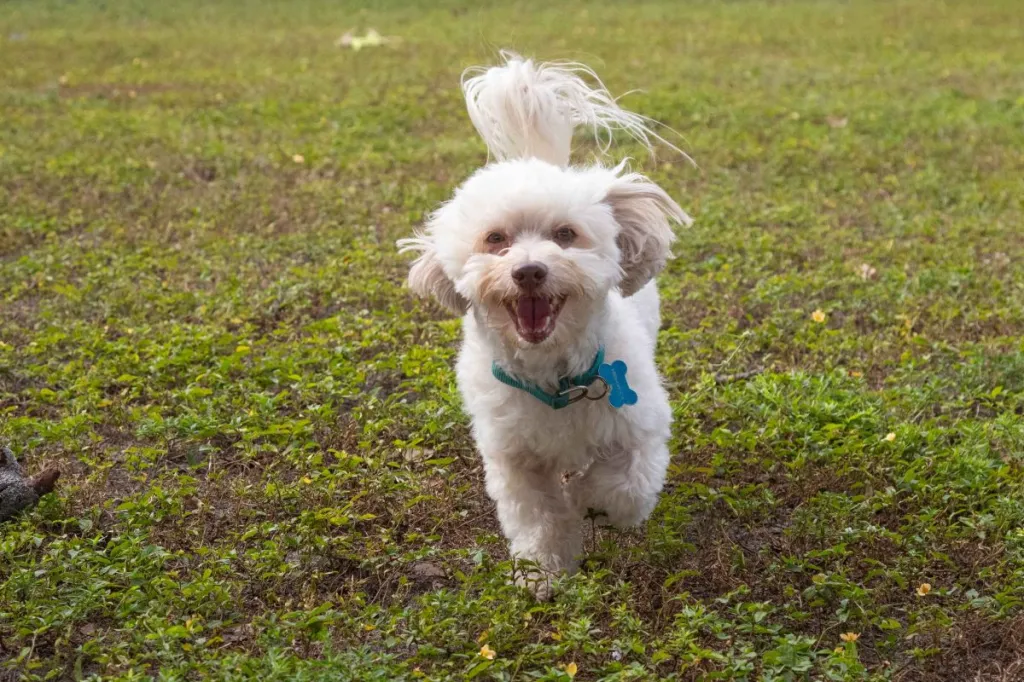
Is a Havapoo hypoallergenic?
Yes, Havapoos are often considered hypoallergenic due to their Poodle parent’s low-shedding, curly coat, which helps reduce the amount of dander that typically triggers allergies. While no dog breed is completely hypoallergenic, Havapoos tend to produce less dander than many other breeds, making them a popular choice for individuals with mild allergies. However, it’s important to note that individual reactions to dog allergens can vary, so spending time with a Havapoo before bringing one into your home is recommended if you have allergies. Regular grooming and care, such as frequent brushing and bathing, can also help minimize allergens.
Physical features and appearance
Size and build
- Size: Small, typically weighing 7–20 pounds and standing 8–15 inches tall.
- Build: Compact, sturdy, yet elegant, reflecting a balanced mix of their parent breeds.
Coat color and texture
- Coat: Low-shedding, with textures ranging from soft and wavy to dense and curly.
- Colors: Diverse range, including solid colors like white, black, cream, apricot, and brown, as well as patterns like parti-color, sable, merle, or phantom.
Facial features
- Ears: Floppy and well-furred, enhancing their adorable appearance.
- Eyes: Round, expressive, and typically dark brown, although lighter hazel shades are possible in lighter-colored Havapoos.
- Head: Round or slightly domed skull with a well-defined stop. Their muzzle is medium-length, tapering slightly with a black or brown nose.
How big does a Havapoo get?
The size of a Havapoo depends largely on whether they are bred from a Toy or Miniature Poodle, as well as the genetics of the Havanese parent.
- Toy Havapoos: On the smaller side, usually 7–12 pounds and around 8–11 inches tall.
- Miniature Havapoos: Larger, typically 15–20 pounds and 12–15 inches tall.
Havapoo temperament
Havapoos are renowned for their affectionate, friendly, and intelligent nature, making them ideal companions for individuals and families alike. They thrive on human interaction and are happiest when spending time with their loved ones. These dogs inherit a playful and lively disposition from both parent breeds, ensuring they bring joy and energy to any household. Their adaptable personality allows them to fit into various living situations, from apartments to larger homes, as long as they receive enough attention and stimulation.
Havanese Poodle mixes are also known for their sociable demeanor, often getting along well with children, other pets, and even strangers. Their intelligence, coupled with a strong desire to please, makes them highly trainable and eager learners. However, they can be sensitive and may not respond well to harsh training methods. Positive reinforcement and patience work best with this breed. While they are generally calm and even-tempered, they can develop separation anxiety if left alone for extended periods, as they crave companionship.
Personality and behavior traits
- Affectionate: Loves being close to their owners; thrives on cuddles and attention.
- Sociable: Friendly with kids, pets, and strangers, making them excellent family dogs.
- Playful: Energetic and fun-loving, always ready for games and activities.
- Intelligent: Quick learners who enjoy mental stimulation and training.
- Adaptable: Comfortable in apartments or larger homes, provided they get enough attention.
- Eager to Please: Responsive to positive reinforcement and eager to make their owners happy.
- Sensitive: Requires gentle training methods and lots of encouragement.
- Prone to Separation Anxiety: May become anxious if left alone for long periods.
- Loyal: Forms strong bonds with their family and often becomes a devoted companion.
- Calm: Generally well-mannered, though they can be lively during playtime.
Training and socialization
Early socialization and positive reinforcement training are crucial due to their intelligence and potential stubbornness. Of course, their intelligence and eagerness to please allow them to pick up commands quickly, so early training is key to establishing good behavior from the start. Use praise, treats, and affection to reward desired behavior.
Training tips:
- Be Consistent: Consistency is crucial in training. Use the same commands and routines to avoid confusion. This helps your Havapoo understand what is expected of them.
- Keep Training Sessions Short and Fun: Havapoos are intelligent but can lose interest if training sessions are too long or repetitive. Keep sessions short (10-15 minutes) and engage with varied activities.
- Mental Stimulation: Incorporate puzzle toys, obedience training, and interactive games into their routine to challenge their mind. A bored Havapoo can become restless or depressed. Once basic obedience is established, teach more advanced commands or tricks.

Havapoo History
The Havapoo, also known as the Poovanese or Havadoodle, gained popularity in the late 20th and early 21st centuries, as demand for hypoallergenic, companion dogs grew. The Havanese. one of the Havapoo’s patent breeds, is a toy breed originating from Cuba, where they were bred as companion dogs for the Cuban aristocracy. Their lineage traces back to small Bichon-type dogs brought to Cuba by Spanish settlers in the 1500s. Over time, these dogs adapted to the Cuban climate and developed their unique silky coats. Known as the “Velcro dog” for their strong attachment to their owners, Havanese dogs are beloved for their cheerful, affectionate personalities.
The Poodle, one of the most intelligent dog breeds, originated in Germany as a water retriever but became closely associated with France, where the breed was refined into three size varieties: Standard, Miniature, and Toy. The smaller Poodle varieties were bred for companionship and gained popularity among European nobility. Poodles are celebrated for their hypoallergenic, curly coats and their trainability, making them a favorite in crossbreeding programs By blending these two distinguished lineages, the Havapoo was created to offer families a versatile, affectionate, and low-shedding companion. Their increasing popularity reflects their adaptability and endearing personality, making them a sought-after breed for dog lovers worldwide.

Havapoo care
As with all dogs, it’s important to keep up your Havapoo’s regular veterinary checkups to detect any health concerns early. Your vet can help you develop a care routine that will keep your dog healthy.
How to groom a Havapoo
Brushing and bathing:
- Brushing: Brush your Havapoo 3–4 times a week to prevent tangles and matting. Use a slicker brush or a comb suitable for curly or wavy coats.
- Bathing: Bathe your Havapoo every 4–6 weeks, or as needed if they get dirty. Use a gentle, dog-safe shampoo to protect their sensitive skin.
Fur trimming:
- Hair Trimming: Schedule a professional grooming session every 6–8 weeks to keep their coat tidy. You can opt for popular styles like the teddy bear cut or keep the coat longer if you prefer.
- Paws: Trim the fur between their paw pads and check for debris regularly.
Don’t forget these!
- Nails: Trim their nails every 3–4 weeks or when you hear them clicking on the floor. Use dog nail clippers or a grinder to avoid splitting.
- Teeth: Brush their teeth 2–3 times a week with dog-specific toothpaste to prevent dental issues. Never use human toothpaste, as it is often toxic to dogs!
- Eyes: Gently wipe away tear stains or debris daily using a damp cloth or a tear-stain remover.
- Ears: Check and clean their ears weekly using a vet-approved ear cleaner. Trim any excess hair around the ear canal to prevent infections.
Flea, tick, and parasite control
Keep up with flea and tick prevention treatments, especially if your Havapoo spends much time outdoors. Regular grooming allows you to spot parasites early.
Early acclimation is key
Getting your Havapoo accustomed to grooming procedures from a young age makes the process easier and more enjoyable for both of you. Handle their paws frequently, examine their mouth and ears, and reward them for good behavior during grooming sessions. This positive foundation sets the stage for stress-free veterinary exams and handling throughout their lives.
Feeding and nutrition
Havapoos require a well-balanced diet tailored to their size, age, activity level, and overall health. High-quality dog food, whether commercially prepared or home-cooked under veterinary supervision, is essential to meet their nutritional needs. Their diet should include an appropriate balance of protein, healthy fats, and carbohydrates, along with the necessary vitamins and minerals to maintain optimal health.
Portion control is crucial for Havapoos, as they are prone to weight gain and obesity. Puppies require smaller, more frequent meals to support their rapid growth, while adult Havapoos benefit from two measured meals a day to sustain their energy levels. Senior Havapoos may need lower-calorie diets to prevent excessive weight gain while supporting their aging bodies. Treats should be limited and given in moderation to avoid overfeeding and to maintain a healthy weight.
Puppies (2–12 months)
- Meals per Day: 4 meals (reduce to 3 meals after 6 months).
- Portion Size: 1/4 to 3/4 cup of puppy food daily, divided into meals.
- Notes: Choose high-quality puppy food rich in protein and nutrients for healthy growth.
Adults (1–7 years)
- Meals per Day: 2 meals.
- Portion Size by Weight:
- 8–12 lbs: 1/2 to 1 cup of food daily.
- 13–20 lbs: 3/4 to 1 1/3 cups of food daily.
- 20-30 lbs: 1 1/3 to 2 cups of dry food per day.
- Notes: Select a balanced adult dog food that supports their energy levels and maintains a healthy weight.
Seniors (7+ years)
- Meals per Day: 2 smaller meals.
- Portion Size: Similar to adults, but adjust based on reduced activity.
- Notes: Consider senior-specific formulas to support digestion, joint health, and lower calorie needs.
Havapoo health
Havapoos are generally pretty healthy dogs. Mixed breeds tend to “breed out” some of the prominent maladies in purebred lines, with genetics selecting the strongest from each side. Also, small dogs tend to live longer than large dogs. However, a Havapoo may be inheriting health issues from both Havanese and Poodles. The most common issues for Havapoos include:
- Hip Dysplasia: Hip dysplasia is a developmental malformation of the hip joint, where the ball and socket don’t fit together properly. This can lead to wear and tear, pain, and eventually arthritis in the affected joint.
- Patellar Luxation: Patellar luxation is a condition where the kneecap (patella) dislocates or moves out of its normal position. This displacement can cause lameness, pain, and difficulty in walking.
- Eye Issues: This is a broad term encompassing various ocular conditions that can affect a dog’s eyes. Common issues include cataracts (clouding of the eye’s lens), progressive retinal atrophy (degeneration of the retina leading to vision loss), and other disorders that may impact vision.
- Deafness: Deafness refers to the partial or complete loss of hearing. In dogs, it can be congenital or acquired due to age, injury, or certain medical conditions.
- Thyroid Issues: Thyroid issues in dogs typically involve disorders of the thyroid gland, which can result in hormonal imbalances. Hypothyroidism, where the thyroid produces insufficient hormones, is a common condition in some breeds.
- Addison’s Disease: Also known as hypoadrenocorticism, Addison’s disease is a disorder where the adrenal glands do not produce enough hormones. This can lead to symptoms such as weakness, lethargy, vomiting, and weight loss.
- Epilepsy: Epilepsy is a neurological disorder characterized by recurring seizures. These seizures can vary in severity and may be caused by various factors, including genetic predisposition, brain injury, or underlying health conditions.
Family compatibility
Havapoos are excellent family dogs due to their affectionate, gentle nature. They thrive in households where they can receive plenty of attention and companionship. Their playful and loving temperament makes them great with children, and they tend to enjoy being part of family activities. Havapoos are typically patient and tolerant with kids, often forming strong bonds with younger family members. However, like all dogs, they should be supervised around very young children to ensure safe and respectful interactions. Their moderate energy levels make them adaptable to both active families and those who prefer a more relaxed pace
Do Havapoo dogs get along with other pets?
When it comes to other pets, Havapoos are generally friendly and sociable. Their easygoing disposition and adaptability make them a good fit for homes with other dogs and even cats. Havapoos often enjoy the company of other animals and are not known to be overly territorial or aggressive. However, early socialization is key to ensuring they get along well with other pets, especially if they are introduced to them as puppies. As with all dogs, it’s important to provide a safe environment and monitor interactions to foster positive relationships with other pets.
Rescue groups and advocacy
Rescues specifically for Havapoos might be hard to come by, as this is a designer hybid breed. However, you can always check with your local shelter, and you may want to try a breed-specific rescue that caters to Havanese or Poodle mixes. You can take a look at the following:
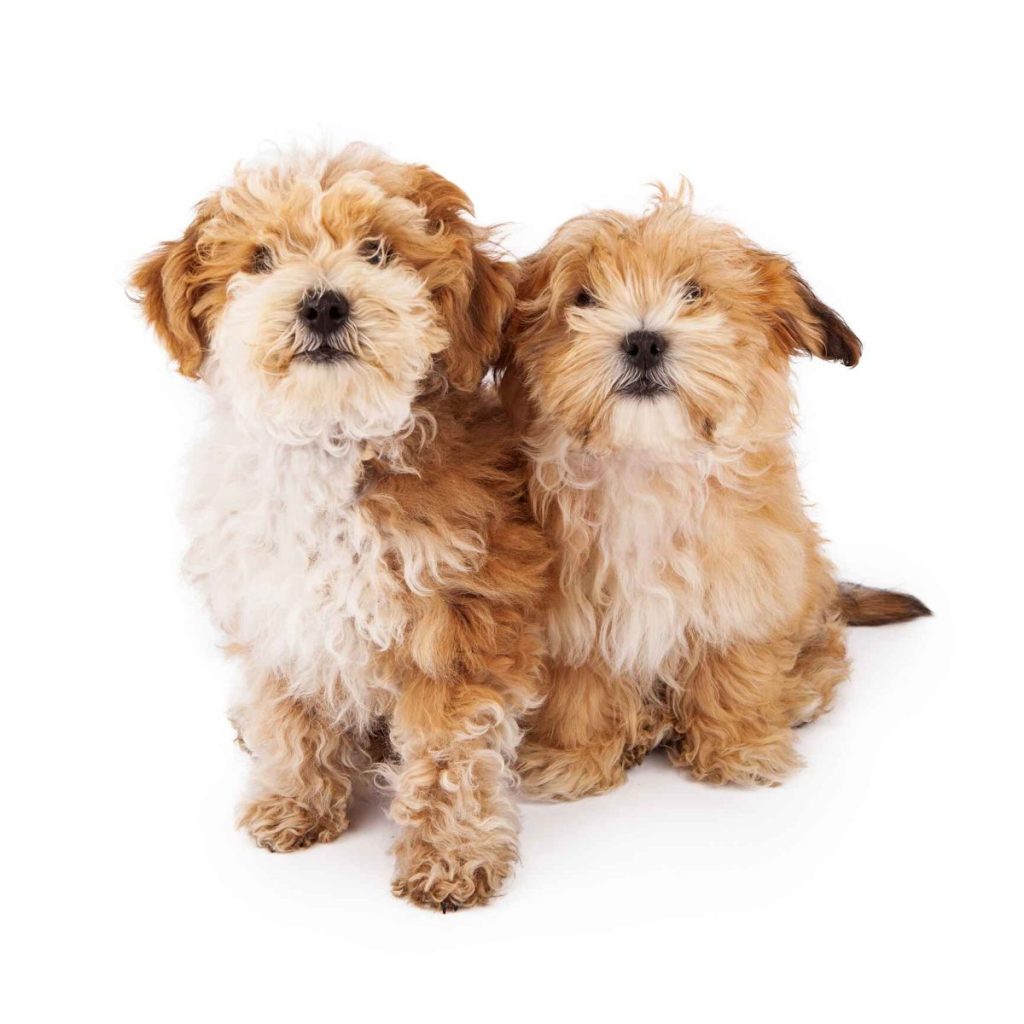
How much are Havapoo puppies?
The cost of a Havapoo puppy typically ranges from $2,000 to $4,500, depending on various factors. These factors include the breeder’s reputation, the puppy’s lineage, location, and whether the puppy has been health-tested or comes from champion bloodlines.
In some cases, the price may be higher if the Havapoo has unique traits, such as a rare coat color or exceptional pedigree. It’s important to choose a reputable breeder who prioritizes the health and well-being of their puppies. Additionally, adoption fees from shelters or rescue organizations may be lower, though availability can be more limited.
